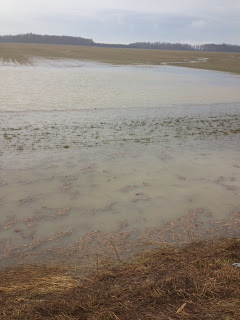In the local tributary known as Fish Creek the water stopped flowing last summer. That proved to be a shock to the fish population. The water always flows in Fish Creek. This past week the water and other things were flowing down in large quantities.
I know you really don't care about Fish Creek. What about the flooded wheat fields?
The recent heavy rain is why we discourage early nitrogen application on wheat. The wheat does not need nitrogen yet and the risk of losing the N is high. Run-off is the obvious risk with high water. Leaching is an additional risk in sandy soils but in our clay loam soils denitrification is the problem. Denitrification is the process where the nitrate form of N is converted to N2 gas by bacteria that survive in water logged soils. N2 gas is lost directly to the atmosphere. Temperature plays a big role in how fast the process happens. When it is cold denitrification losses are low. As soils warm the process speeds up. Regardless, there is too much time lag between late March and 1st week in April applications of nitrogen and the needs of the wheat crop.
The flooded wheat still has a fighting chance. The plants have just started to break dormancy. Their requirement for oxygen is extremely low which means established wheat plant can stand being submerged for over 48 hours. The water is cold which helps extend this further because cold temperatures slow down respiration in the plant which reduces its oxygen needs and cold water contains more dissolved oxygen. The wheat plant doesn't have gills, but every little advantage helps in these conditions.
Spring will happen in 2013. It always has and always will.


No comments:
Post a Comment